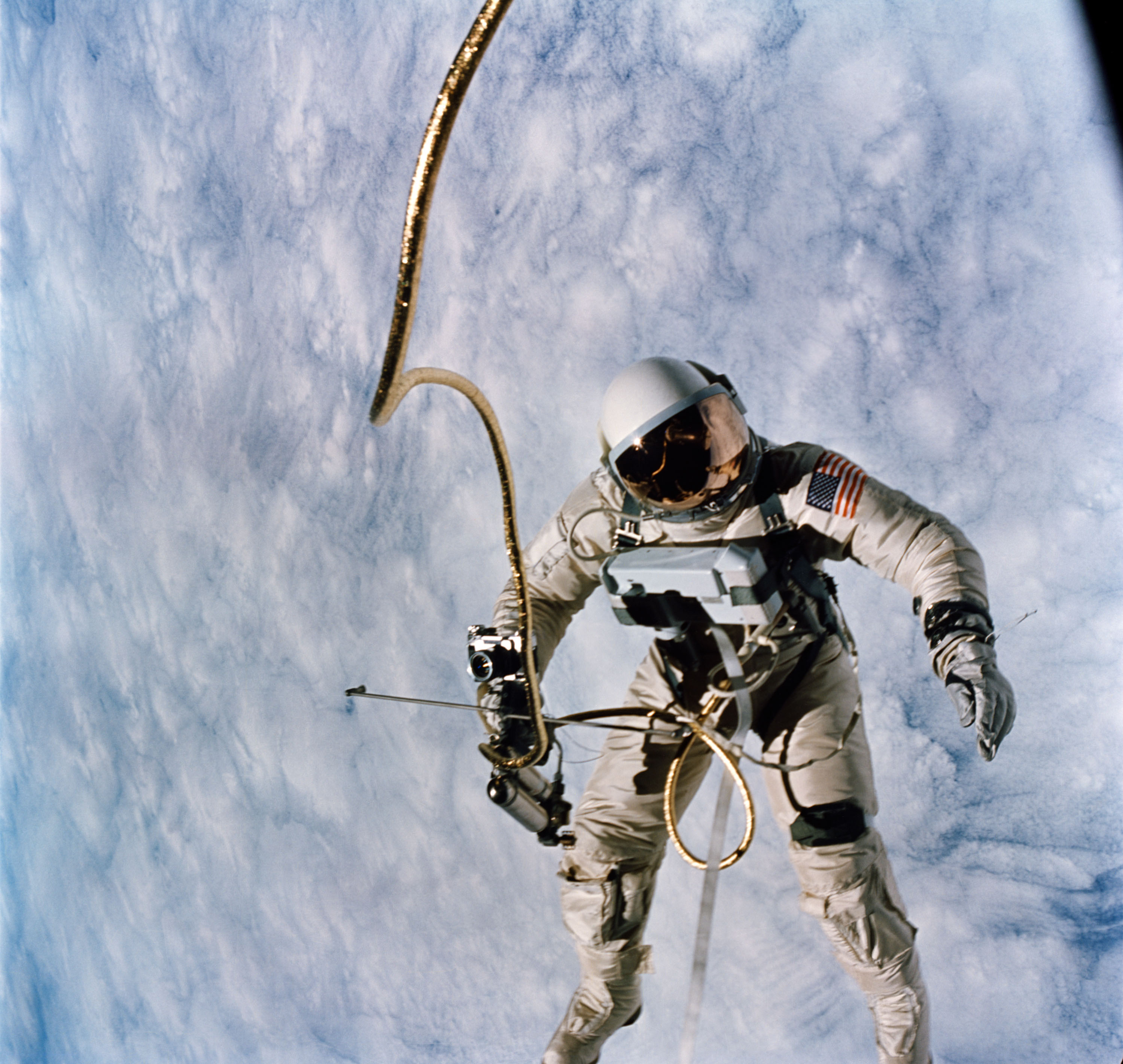
Fifty years ago, in the first week of June 1965, the the United States took a huge step forward in its drive to land a man on the Moon. As described in yesterday’s AmericaSpace article, Gemini IV astronauts Jim McDivitt and Ed White were tasked to spend four days in orbit—longer than any previous American crew—and support their nation’s first Extravehicular Activity (EVA), or “spacewalk.” Neither accomplishment was a true “first” or an empirical record, for the Soviets had already done both, but for a relieved America the mission offered tangible proof that the late President John F. Kennedy’s goal of bootprints on the Moon before 1970 was in sight. McDivitt and White’s voyage is a case of being in the right place at the right time. When their names were announced in July 1964, Gemini Deputy Program Manager Kenneth Kleinknecht mentioned that one of them might perform a “stand-up EVA,” by opening the hatch and poking his head into the void of space. Yet it took several months, and no small amount of lobbying by the astronauts themselves, for the audacious plan to bear fruit.
Physical conditioning was critical for White, and, during training, he spent 60 hours in vacuum chambers, rehearsing the opening of Gemini IV’s overhead hatch, pushing himself outside, and moving around in a mockup space suit at simulated altitudes of 34 miles (55 km). In addition to his 22-layer suit, which weighed just 31 pounds (14 kg), he would use a hand-held maneuvering gun, equipped with two cylinders of compressed oxygen, to move around. However, even in the final days before launch, there was scepticism in some areas of the press that this was little more than an attempt to keep up with the Soviet Union. At one press conference, Lead Flight Director Chris Kraft snapped: “We’re not trying to play Mickey Mouse with this thing! I don’t think it’s very fair to suggest we’re carrying out a propaganda stunt.”
Early on 3 June 1965, McDivitt and White were awakened in their quarters at Cape Kennedy, Fla., and began the process of medical checks, a steak-and-eggs breakfast, and suiting-up, and were at the foot of Pad 19 and their Titan II launch vehicle by 7:07 a.m. EDT. Since the EVA would require the depressurization of Gemini IV’s entire cabin—thus exposing McDivitt to vacuum, as well as White—both men underwent a “pre-breathing” exercise to flush nitrogen from their blood and avoid an attack of the “bends.” With a familiar high-pitched whine of its engines, the Titan II booster speared for the heavens at 10:16 a.m., to synchronized yells of “Beautiful!” from both astronauts.
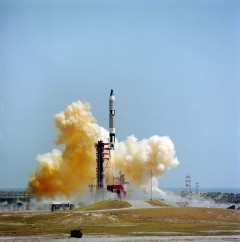
Achieving orbit shortly afterwards, McDivitt’s first task was to perform a station-keeping exercise with the second stage of the Titan … and it was here that the first difficulties arose. The stage had been fitted with flashing lights, but had never been designed as a rendezvous target, and when it entered orbital darkness it was virtually invisible. Added to the confusion was its tumbling motion, which left the astronauts cautious about getting too close. Judging its distance by eyesight alone was problematic—McDivitt estimated it to be 425 feet (130 meters) away, White thought it was about 230 feet (70 meters) away—and as they fired Gemini IV’s thrusters to approach, it seemed, inexplicably, to move “away” and “downward.” A few minutes later, the separation distance seemed to have increased … to around 1,970 feet (600 meters). Aware that he was wasting precious fuel, McDivitt asked for the recommendation of Chris Kraft: Which objective was most important—the rendezvous test or White’s EVA? Since the latter was one of the main goals, the rendezvous attempt was abandoned.
Rendezvous was planned for a subsequent mission, Gemini VI, and its pilot, Tom Stafford, noted the difficulties in his autobiography, We Have Capture. “Jim’s instinctive move was to thrust toward it,” Stafford wrote, “as though he were flying formation in a jet airplane. By doing so, he increased the speed and moved into a higher orbit, even further behind the booster. The only way to get even close to the Titan … would have been to fire thrusters ‘retrograde’—against the direction of travel—slowing the Gemini down and dropping its orbit.” It was an early lesson in orbital mechanics: adding speed raises altitude, moving a spacecraft to a higher orbit than the target. However, paradoxically, a faster-moving vehicle actually slows in comparison to its quarry, since its orbital period (a function of distance from the center of gravity) also decreases. To catch up with a target “ahead” of them, astronauts needed to drop into a lower orbit, then rise back up in order to meet it. “It’s a hard thing to learn,” wrote Deke Slayton in his autobiography, Deke, “since it’s kind of backward from anything you know as a pilot.”
To be fair, both McDivitt and White had done very little rendezvous training. The station-keeping exercise had already wasted 42 percent of their fuel supply. McDivitt knew that his partner was hot and tired and told mission controllers that he wanted the EVA postponed from the second to the third orbit. Chris Kraft agreed and the two men spent some time relaxing, watching the Gulf of Mexico drift “below” them and chatting to fellow astronaut Gus Grissom. Next, they dived headfirst into the 54-item checklist to ready the EVA equipment. At the end of the process, White snapped a gold-tinted faceplate onto his helmet, hooked up the 24-foot-long (7.4-meter) umbilical to provide oxygen and communications with McDivitt, and strapped the chest pack onto his torso. He checked his camera three times, making sure he had not left the lens cap stuck on. “I knew I might as well not come back if I did,” he later quipped.
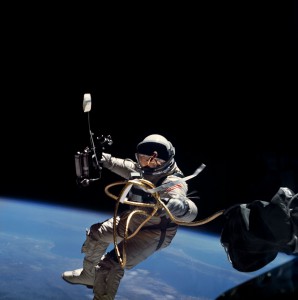
Depressurization of Gemini IV’s cabin began over Australia, but hit a snag when White’s overhead hatch refused to unlatch. A spring had failed to compress properly. At length, four hours and 18 minutes after launch, at 2:34 p.m. EDT on 3 June 1965, he cranked a ratchet handle to loosen a set of prongs lining the opening of the hatch, raised it to 50-degrees-open and poked his helmeted head into the fathomless void. White then pushed himself “upward” from his seat and caught his first awe-inspiring glimpse of Earth: the intense blue of the Pacific Ocean and, coming up to the east, Hawaii.
Losing no time, he tested the hand-held maneuvering gun and found that it responded crisply, squirting bursts propel himself to the base of Gemini IV and then to its nose. Within minutes, its gas supply was gone and White spent the remainder of his 21 minutes outside twirling, twisting, and hand-pulling himself backwards and forward along his tether. Inside the spacecraft, McDivitt had the difficult task of keeping Gemini IV steady. The long tether was also troublesome, as it kept tugging America’s first spacewalker toward the rear of the spacecraft, whose thrusters periodically spurted a nasty mix of monomethyl hydrazine and nitrogen tetroxide—”hypergolics” which White definitely did not want on his suit.
Approaching the California coastline, Gus Grissom asked for photographs. “Get out in front where I can see you,” McDivitt called, and White complied. In less than a quarter of an hour, he had “walked” from the central Pacific, crossed California, and, very soon, the two astronauts were gliding serenely over Houston, talking to Grissom. Suddenly, McDivitt’s voice burst with excitement. “There’s Galveston Bay, right there,” he yelled. “Hey, Ed, can you see it on your side of the spacecraft?” White certainly could and he snapped a photograph with the 35mm camera. McDivitt was also taking pictures, although he admitted that “they’re not very good.” Ironically, those images of White, tumbling in space, turned out to be among the most iconic of the Sixties. A 16mm movie camera also captured his tumble, backdropped by a cloud-studded, blue-and-white Earth.
Each time McDivitt or White spoke, the Gemini’s voice-activated system cut off messages from Mission Control … and since they spoke a lot during those exhilarating minutes, Grissom had a hard time trying to contact them. At length, with some urgency in his voice, he made himself heard.
“Got any messages for us?” asked McDivitt.
“Ed! Come in here!” yelled Grissom. “Gemini IV, get back in!”
Describing the end of his historic EVA as “the saddest moment of my life,” White brought his feet back down through the open hatch, onto his seat, and finally below the instrument panel. To assist his partner, McDivitt turned up the cabin lights as a guide. Gemini IV had sailed over the eastern Atlantic Ocean into orbital darkness and White had “walked” across most of the Pacific and all of the United States … in 21 minutes. His last view was of the entire southern portion of Florida, parts of Puerto Rico, and Cuba.
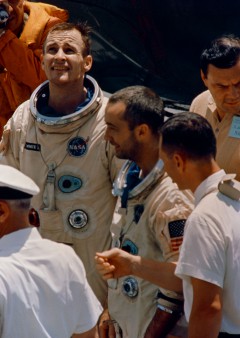
His pulse of 50 beats per minute, though, soared to 178 in these final moments. He closed the hatch over his head and reached for the handle to lock it, realizing that it would be as hard to seal as it had been to open. As White pushed on the handle, McDivitt pulled onto him to offer him some leverage. Eventually, the hatch was secured. The official end time of the first American EVA was 3:10 p.m., some 36 minutes between hatch opening and closure … and less than five hours into Gemini IV’s four-day mission. White had far exceeded his suit’s cooling capacity—producing severe condensation in his helmet and sweat streaming into his eyes—and the hatch problems prompted Mission Control to tell him not to re-open it to discard unwanted equipment. In his post-flight debriefing, White recounted that his hand-held maneuvering gun worked in pitch and yaw axes, but in roll it was more difficult, without using excessive fuel. He experienced no vertigo or disorientation, nor did he feel any inkling of the tremendous speed at which he was travelling.
The next four days, however, would be anything but comfortable. Their freeze-dried or dehydrated food—beef pot roast, banana pudding, fruit cake, and even “space sandwiches”—sounded appealing, but the need to mix them with water and knead until mushy lessened their attractiveness. Spaghetti was rehydrated by water pistol. “Washing” (if it could be described as such) was done with small, damp cloths, urine was dumped overboard, and feces were stored in self-sealing bags with disinfectant pills.
In the cramped confines, a bungee cord had been provided to keep the men’s fitness up, but even White found that his desire to do strenuous work dwindled as the mission dragged on, perhaps due to a lack of sleep. The men remained in good spirits, although on one occasion McDivitt told flight surgeon Chuck Berry that he felt “pretty darn woolly” and needed a bath. When the two men returned to Earth on 7 June 1965, they were described as heavily bearded and sweaty, their faces lined with tiredness, although that did not prevent McDivitt from letting out a whoop of joy on the deck of the recovery ship USS Wasp. Both astronauts had lost weight, but were in good physical shape after four days … to such an extent that, 24 hours after splashdown, White spotted a group of Marines and midshipmen having a game of tug-of-war and joined them for 15 minutes. Although “his” team lost, White certainly appeared fit and healthy.
Congratulations from President Lyndon B. Johnson was accompanied by joint Air Force promotions for both McDivitt and White from Major to Lieutenant Colonel and NASA’s Distinguished Service Medal. Elsewhere, the University of Michigan—both men’s alma mater—awarded them both honorary doctorates in astronautical science. “I can hardly get used to people calling me Colonel,” joked White. “I know in a million years I’ll never get used to people calling me Doctor!”
Before they could accept their new accolades, however, McDivitt and White needed to take a shower … but White wondered what all the fuss was about. “I thought we smelled fine,” he said of their “distinct aroma,” after four days without a proper wash. “It was all those people on the carrier that smelled strange!”
This is part of a series of history articles, which will appear each weekend, barring any major news stories. For the first 10 days of June, to commemorate the 50th anniversary of America’s first spacewalk, AmericaSpace will look back at 10 pivotal EVA missions from U.S. history over the past five decades.
Want to keep up-to-date with all things space? Be sure to “Like” AmericaSpace on Facebook and follow us on Twitter: @AmericaSpace




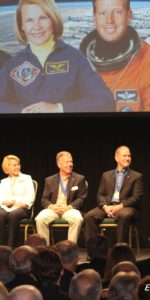
Knowing Ed White’s future with Apollo 1, it is doubly sad to see these images of his only EVA. So close and yet so far from his goal of space exploration!
Indeed. But one can take comfort in the knowledge that, according to the Many Worlds Interpretation of quantum mechanics, there are worlds where he avoided that fate one way or another, and all of them are just as real as this one. An observer outside the system of worlds — God, Brahman, Azathoth — cannot point to any one of the worlds and say “this is the true real world, all the others are might have beens.”
I just finished serializing a short novel, A Separate War, set in a world where the Apollo 1 astronauts escaped in the nick of time, and the history of space exploration went very differently. My current serial, Holovideo, takes place in the same world, but space history is peripheral to the storyline. I’m also working on a novel in which a character from this world (or at least one similar to it) is transpositioned into that world, and at least once she thinks how wonderful it is to finally live in a world where she can enjoy Ed White’s first EVA with him and not have it blighted by knowing what a terrible fate awaits him less than two years later.
I was recently at the University of Michigan School of Aeronautical and Aerospace Engineering and they have prominently featured two very nice displays about Ed White and Jim McDivitt. Great article Ben. Also, “Escaping The Bonds Of Earth The Fifties and the Sixties” is EXCELLENT in every way. If I was a professor at university, your book would be required reading (even if I was teaching Underwater Basket Weaving or Medieval Music Appreciation). I am grateful to have your book in my collection Ben. Thank you.
I believe Ed White’s hand held maneuvering unit actually used compressed nitrogen, and not oxygen as a propulsive gas.
Carl, the HHMU used on Gemini 4 employed compressed oxygen as its propellant not nitrogen. One of the concerns in choosing the gas in the HHMU was ensuring that there would be no problem if a leak developed. Nitrogen was considered since it is inert but a leak would dilute the 5 psi oxygen atmosphere in the crew cabin. In the end, oxygen was chosen since a leak would present no safety issue for the crew.